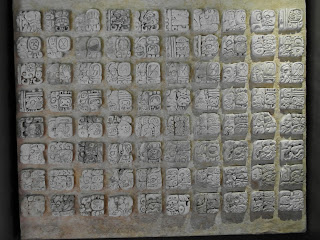After more than a month on
the coast we thought it was time to head back inland and get another dose of
culture. And of course that came in the form of more Mayan ruins. First up were
the ruins in Palenque, which is located in the south of the country. It's quite
a small city but is obviously a tourist hot spot because of the ruins. Rather
than stay in town though, we headed out to El Panchán, which is the most
popular place to stay for backpackers. It's a sprawling collection of
accommodation options (generally fairly basic) and a couple of restaurants and
bars set in a dense patch of rainforest. We got a room for just over $11 a
night, thankfully located far enough away from the bar so it didn't keep us
awake all night. And the whole complex is only a couple of kilometers from the
ruins themselves, which meant we could easily walk there.

Palenque is a medium-sized archaeological site, much smaller than some of the bigger ones like Tikal (in Guatemala). But, as everyone knows, size doesn't mean everything. What Palenque may lack in size it makes up for in impressive architecture, detail and fine sculptures - some of the finest the Mayas produced. We spent a couple of hours wandering around the site, climbing up some of the structures where we could and inspecting the ancient carvings. Dating back to 226 BC, it's astonishing to see what these ancient people built with their bare hands. I wonder how many of our modern structures will remain after so long. They definitely won't be as beautiful in a ruinous state.
Despite the amount of excavation done over the years, it's estimated that less than 10% of the total area of the city has been discovered. That means there's still probably about a thousand structures still covered by the jungle. Maybe it would match up to the big boys in size after all. We also took a look at the museum just down the road from the ruins, which had some helpful explanations about the site. It was also a good place to shelter from the sudden rain before our walk back to El Panchán.
Next, we headed up to Mérida
which is the largest city on the Yucatán Peninsula. It's quite an attractive
city with the usual big buildings and cathedrals, and surprisingly it was
actually quite cool at night which was a nice change. We were mainly here to visit
Chichen Itza but we spent a few more days just chilling out and visiting a
cenote nearby, which turned out to be a real highlight. There are quite a few
cenotes in the area, but we chose the San Ignacio cenote as it was just a short
ride away on a local bus rather than having to do a tour. A cenote is a deep
natural pit, or sinkhole, created when limestone bedrock collapses, exposing
groundwater underneath. The San Ignacio cenote is only small, and you access it
by climbing down a steep set of stairs underground. You then find yourself in a
cavern, with stalactites hanging from the domed type roof and the most
beautiful crystal clear turquoise water, perfect for swimming. We went at about
10 or 11am and we were the only ones there, so we had the whole cenote to
ourselves for about 30mins. The water is refreshingly cool and while there's
not much in the way of fish to look at, it's such a stunning setting to be in.
The main event though, was
Chichen Itza, a couple of hours from Mérida. It's one of the largest Maya
cities, and one of the most visited archaeological sites in Mexico. There were
loads more tourists here than at Palenque, especially huge tour groups which we
try to avoid like the plague. Unless of course we're trying to eavesdrop on the
English speaking ones to find out some facts. The site is quite big with
structures and buildings all over the place, in various stages of ruin. The
Great Ball Court is the largest and best preserved ball court in ancient
Mesoamerica, and is where the ancient Mayan ballgame, ending in human sacrifice
(by decapitation), was played. The most famous structure of Chichen Itza,
however, is the Temple of Kukulkan, a 30m high pyramid with stairs up all four
sides. Back in the day you used to be able to climb up to the top, but they
obviously realised that wasn't helping maintain the condition, so it's roped
off now. There's even a cenote on the site, where, according to archaeological
investigations, human sacrifices were made in times of drought.  |
| The cenote in the Chichen Itza site |
 |
| The Temple of Kukulkan |
After a couple of hours of wandering around we thought it was time to escape the masses and get away from the annoying tour groups. There's one more ruin to visit in Mexico but first, it's time to go to Cuba.














No comments:
Post a Comment